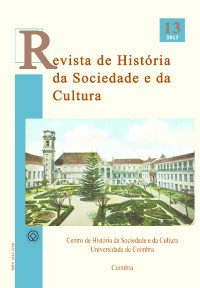Please use this identifier to cite or link to this item:
https://hdl.handle.net/10316.2/39388| Title: | Marcos de referência e topónimos da cidade medieval portuguesa: o exemplo de Coimbra nos séculos XIV e XV | Authors: | Campos, Maria Amélia Álvaro de | Keywords: | Portuguese medieval town;Coimbra;Urban landscape;Toponymy;Cidade medieval portuguesa;Coimbra;Paisagem urbana;Toponímia | Issue Date: | 2013 | Publisher: | Centro de História da Sociedade e da Cultura | Abstract: | Com este artigo, pretende-se reflectir acerca da toponímia da cidade da Baixa Idade Média
portuguesa, a partir do estudo mais detalhado da realidade de Coimbra, nos séculos XIV
e XV. Assente num corpo documental constituído por documentos de produção eclesiástica,
régia e concelhia, cronologicamente balizado entre o século XIV e os inícios de Quinhentos,
este trabalho procura identificar os principais marcos de referência topográfica, naturais ou
artificiais, que se impunham na paisagem urbana. Do mesmo modo, pretende sublinhar a
forma como a toponímia medieval nos dá eco das populações que animavam a urbe nos
séculos que estudamos, mas também dos povos que, protagonistas de ocupações anteriores,
deixaram, até bem tarde, um cunho diferenciador no urbanismo de Coimbra. Finalmente, este
estudo ambiciona uma melhor compreensão da relação que se estabelecia entre o habitante
citadino e o espaço urbano. Para uma melhor articulação destas questões, o artigo divide-se
em quatro temas evidenciados pela toponímia em análise: edifícios e construções urbanas;
paisagem e características naturais; actividades artesanais e comerciais e outras profissões;
minorias religiosas e estrangeiras. With this article, we pretend to conduct an analysis about the city toponymy of the Portuguese Middle Ages, from the more detailed study of the reality of Coimbra, in the fourteenth and fifteenth centuries. Based on a body of documents consisting on documents written by ecclesiastical, district and royal institutions, chronologically marked out between the fourteenth century and the beginning of the sixteenth century, this work seeks to identify the main topographic landmarks, either natural or built, that stood out in the urban landscape. In the same way, wishes to emphasize the way the medieval toponymy gives us echoes from the population that gave life to the city in the centuries that we now study, but also the people who, protagonists of previous occupations, left until late a distinctive stamp in the urbanism of Coimbra. Finally, this study aims a better comprehension of the relationship that was established between the city inhabitant and the urban space. For a better articulation of these issues, this article is divided in four themes highlighted by the toponymy in review: buildings and urban constructions; landscapes and natural features; craft and commercial activities and other professions; religious and foreign minorities. |
URI: | https://hdl.handle.net/10316.2/39388 | ISSN: | 1645-2259 2183-8615 (digital) |
DOI: | 10.14195/1645-2259_13_6 | Rights: | open access |
| Appears in Collections: | Revista de História da Sociedade e da Cultura |
Files in This Item:
| File | Description | Size | Format | |
|---|---|---|---|---|
| marcos_de_referencia_e_toponimos.pdf | 3.04 MB | Adobe PDF |  |
Items in DSpace are protected by copyright, with all rights reserved, unless otherwise indicated.
